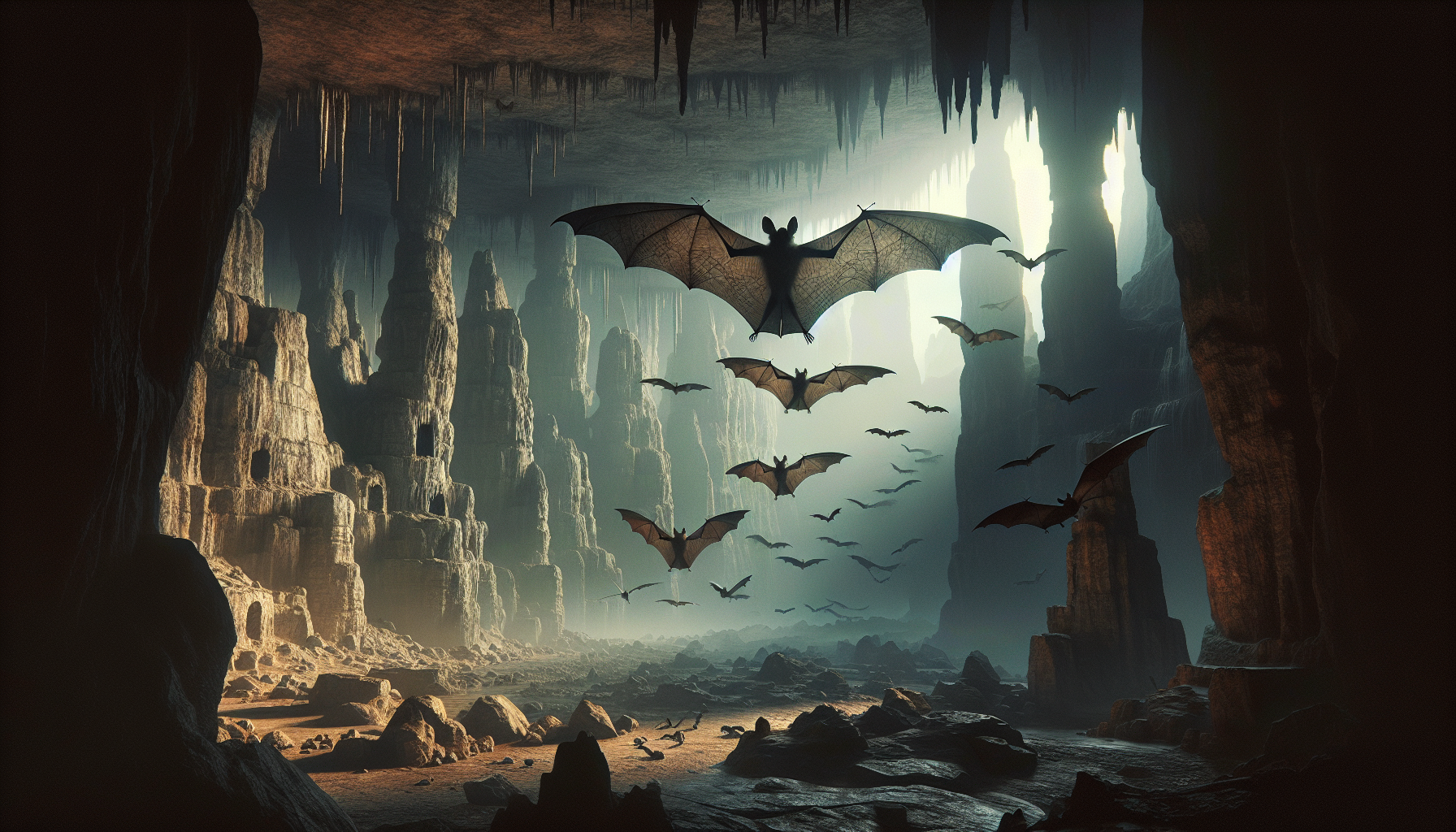In the dimly lit corners of our planet, where the sun rarely ventures and shadows reign supreme, lies a world that teeters on the edge of the unknown: the realm of bats. These enigmatic creatures have long fascinated and frightened us in equal measure, flitting silently through the night skies and evoking images of haunted castles and eerie caves. But beyond the myths and legends, bats play an intriguing and often misunderstood role in our ecosystems. Welcome to the mysterious world of bats in the underworld, where we will uncover their secrets and explore their fascinating roles in the shadows. 🌌
Bats, with their unique abilities and adaptations, have long been the subjects of both scientific inquiry and folklore. Yet, despite their ubiquitous presence in cultural stories, many of us know little about the real lives of these nocturnal creatures. This article seeks to change that by delving into the biology, behavior, and ecological significance of bats. From their sophisticated echolocation systems that rival the most advanced human technologies to their vital roles as pollinators and pest controllers, bats are more than mere Halloween symbols; they are keystones of biodiversity with stories to tell.
Our journey begins by examining the incredible diversity of bat species. With over 1,400 species worldwide, bats make up nearly a quarter of all mammalian species, showcasing a staggering variety of forms and functions. We’ll explore some of the most remarkable adaptations that have allowed bats to thrive in diverse environments, from rainforests and deserts to urban landscapes. You’ll meet fruit bats with wingspans that rival those of birds of prey and tiny insect-eating bats that weigh less than a penny. Each species has carved out a unique niche, contributing to the intricate tapestry of life on Earth.
Next, we’ll delve into the fascinating social structures and communication methods of bats. While many people imagine bats as solitary creatures, they often live in complex colonies with sophisticated social hierarchies. We’ll uncover how these colonies communicate using a range of vocalizations and even songs, as well as the ways in which bats cooperate and compete within their communities. Additionally, we’ll explore the mysterious migratory patterns of some bat species and their astounding endurance as they traverse vast distances.
Finally, we’ll shed light on the critical roles bats play in our ecosystems and the threats they face in a rapidly changing world. As pollinators, seed dispersers, and natural pest controllers, bats contribute to the health of our agriculture and natural environments in ways that often go unnoticed. However, habitat destruction, climate change, and disease outbreaks, such as the devastating white-nose syndrome, pose significant threats to bat populations. By understanding the importance of bats and the challenges they face, we can better appreciate the need for their conservation and the steps we can take to protect these fascinating creatures.
So, prepare to embark on a journey into the shadows, where we’ll uncover the mysterious world of bats and discover their secrets. As we illuminate the lives of these extraordinary animals, we hope to inspire a newfound appreciation for their presence in our world and a commitment to their preservation. Join us as we unravel the mysteries of the night and shine a light on the remarkable role of bats in the underworld. 🦇
The Enigmatic Habitats of Bats
Bats are extraordinary creatures that have intrigued scientists and nature enthusiasts for centuries. Their mysterious world, especially within the underworld—such as caves and subterranean environments—offers a unique perspective on the ecological roles these nocturnal mammals play. The habitats of bats are diverse and complex, ranging from tropical forests to temperate woodlands, and most intriguingly, the underworld. Within these dark, hidden places, bats exhibit behaviors and adaptations that are vital to the ecosystems they inhabit.
One of the most fascinating aspects of bat habitats is their reliance on darkness and secluded spaces. Caves and underground systems provide the perfect environment for many bat species, offering shelter and a strategic advantage in avoiding predators. These environments also offer stable temperatures and humidity levels, which are crucial for bats’ roosting and breeding needs. Interestingly, the underworld serves as both a safe haven and a hunting ground for these nocturnal creatures, where they use echolocation to navigate and hunt with precision.
The role of bats in the underworld extends beyond mere survival. They play a significant part in the ecosystem by controlling insect populations and aiding in pollination and seed dispersal. This ecological balance highlights the importance of preserving these habitats, as bats contribute to maintaining the health of various ecosystems. To better understand these creatures, researchers have delved into the mysterious world of bats, unveiling secrets about their social structures, communication methods, and unique physiological traits that allow them to thrive in such environments.
The Evolutionary Wonders of Bats
Bats are the only mammals capable of sustained flight, a remarkable evolutionary trait that has allowed them to colonize a wide range of environments. The evolution of bats is a testament to nature’s ingenuity, showcasing adaptations that have enabled them to thrive in niches where few other animals can. Their wings, essentially modified hands, have a unique structure of elongated fingers covered by a thin membrane, providing both agility and speed in flight.
Another evolutionary marvel is their echolocation ability, which allows bats to navigate and hunt in complete darkness. This adaptation is so precise that bats can detect objects as thin as a human hair in their flight path. The development of echolocation is considered one of the most sophisticated natural sonar systems, involving the emission of high-frequency sounds and the interpretation of the returning echoes to map their surroundings. This extraordinary skill not only aids in hunting but also in avoiding obstacles and predators.
The evolutionary journey of bats is also marked by their diverse dietary adaptations. While many species feed on insects, others have evolved to consume fruit, nectar, fish, and even blood. This dietary diversity is reflected in their various anatomical and physiological adaptations, such as different tooth structures and digestive systems, allowing bats to exploit a wide range of food sources in the underworld and beyond.
Unveiling Bat Communication and Social Behavior
Bats are highly social creatures, with complex communication systems that enable them to interact and coordinate with each other effectively. Their communication involves a range of vocalizations and behaviors, each serving specific functions within their social structures. These vocalizations include calls for mating, navigation, territory defense, and social interactions, reflecting a rich tapestry of auditory communication.
Research has shown that bats exhibit a variety of social behaviors, such as forming colonies that can range from a few individuals to millions. These colonies often consist of intricate social hierarchies, where bats engage in cooperative behaviors like grooming and food sharing. The dynamics within these colonies are essential for their survival, as they provide protection against predators and environmental challenges.
Moreover, bats are known for their migratory behaviors, with some species traveling long distances between roosting and foraging sites. These migrations are critical for their survival, often driven by seasonal changes and food availability. The ability of bats to navigate over vast distances is another testament to their complex social and ecological adaptations.
Comparative Analysis of Bat Species
The world of bats is incredibly diverse, with over 1,400 species spread across the globe. This diversity is a result of millions of years of evolution, resulting in a wide range of adaptations to different ecological niches. In this section, we will compare some of the most fascinating bat species, highlighting their unique traits and ecological roles.
One of the most well-known species is the Vampire Bat, renowned for its blood-feeding habits. Unlike most bats, vampire bats have evolved specialized heat sensors and anticoagulant saliva to feed on the blood of mammals and birds. In stark contrast, the Fruit Bat or flying foxes are primarily frugivorous, playing a crucial role in seed dispersal and pollination in tropical ecosystems.
Another interesting species is the Fishing Bat, which has adapted to hunting fish and other aquatic prey. With long, sharp claws and a keen sense of echolocation, these bats can detect ripples on the water’s surface, allowing them to catch fish with remarkable accuracy. This specialization showcases the ecological diversity and adaptability of bats across different environments.
| Species | Diet | Unique Traits |
|---|---|---|
| Vampire Bat | Blood | Heat sensors, anticoagulant saliva |
| Fruit Bat | Fruit, nectar | Seed dispersal, pollination |
| Fishing Bat | Fish | Echolocation for aquatic prey |
Understanding these differences is essential for conservation efforts, as each species plays a unique role in its respective ecosystem. By studying their adaptations and ecological contributions, we can develop more effective strategies to protect these vital creatures and their habitats.
Challenges and Conservation Efforts
Bats face numerous challenges in the modern world, from habitat destruction to climate change and disease. These threats have significant implications not only for bats but also for the ecosystems they inhabit. Habitat destruction, particularly the loss of roosting sites in caves and forests, is one of the most pressing issues, often driven by human activities such as deforestation and urban expansion.
Climate change poses another significant threat, as rising temperatures and shifting weather patterns can disrupt bat populations and their food sources. Bats are sensitive to changes in temperature and humidity, which can affect their reproductive cycles and hibernation patterns. As climate change continues to alter ecosystems, bats may struggle to adapt, leading to declines in populations and potential extinctions.
Disease is another critical challenge, with White-nose Syndrome (WNS) being one of the most devastating. This fungal disease has decimated bat populations across North America, causing millions of deaths. Efforts to combat WNS involve research into the disease’s spread and potential treatments, as well as conservation measures to protect affected species.
Conservation Strategies and Community Involvement
Effective conservation strategies require a multi-faceted approach, involving habitat protection, research, and community engagement. Protecting critical habitats, such as caves and forests, is essential for ensuring the survival of bat populations. This involves not only safeguarding existing roosting sites but also restoring degraded habitats to provide suitable environments for bats.
Research plays a crucial role in conservation efforts, as understanding bat behavior, ecology, and disease dynamics is essential for developing effective strategies. This includes studying bat migration patterns, reproductive behaviors, and responses to environmental changes. Advances in technology, such as acoustic monitoring and tracking devices, have significantly enhanced our ability to study bats in their natural environments.
Community involvement is also vital for successful conservation efforts. Educating the public about the ecological importance of bats and dispelling myths about these misunderstood creatures can foster greater support for conservation initiatives. Community-based programs that engage local populations in bat conservation can lead to more sustainable and effective outcomes.
Watch this insightful video on bat conservation efforts by Bat Conservation International.
Technological Innovations in Bat Conservation
Technology has become an invaluable tool in bat conservation, providing new ways to study and protect these creatures. Acoustic monitoring devices allow researchers to record and analyze bat calls, providing insights into their distribution, abundance, and behavior. These devices can be deployed in various environments, from urban areas to remote forests, enabling continuous monitoring of bat populations.
Tracking technologies, such as GPS and radio telemetry, have also revolutionized our understanding of bat movements and migrations. These tools enable researchers to track individual bats over long distances, revealing important information about their migratory routes, roosting sites, and foraging behaviors. This information is crucial for identifying critical habitats and implementing conservation measures to protect these areas.
Additionally, advances in genetic research have opened new avenues for studying bat populations and their responses to environmental changes. Genetic studies can provide insights into population structure, gene flow, and genetic diversity, which are essential for assessing the resilience of bat populations to threats such as habitat loss and disease.

Conclusion
As we draw the curtain on our exploration of the mysterious world of bats in the underworld, it’s clear that these creatures, often shrouded in myth and misconception, play a far more critical and fascinating role than many might realize. Bats, with their unique adaptations and behaviors, are indispensable to the ecosystems they inhabit and offer invaluable insights into ecological and biological processes. This journey into their secretive lives has revealed a tapestry of intriguing behaviors and ecological contributions that challenge our traditional perceptions and invite us to reconsider their place in the natural world.
Throughout this article, we have delved into the extraordinary adaptations of bats that enable them to thrive in the shadowy realms they call home. From their sophisticated echolocation abilities to their diverse dietary habits, bats have evolved to occupy a variety of ecological niches. These adaptations not only underscore their resilience but also highlight their role as essential pollinators, seed dispersers, and pest controllers. By consuming vast quantities of insects, many bat species help maintain the balance in various ecosystems, preventing the overpopulation of pests that could otherwise devastate crops and spread diseases.
Moreover, bats contribute significantly to pollination and seed dispersal, especially in tropical and subtropical regions. Certain species of fruit bats, for instance, are vital for the propagation of numerous plant species, including those with economic importance like bananas, mangoes, and agave. Their nocturnal activities ensure the continued reproduction and genetic diversity of these plants, supporting a wide array of wildlife that depends on them. This interconnectedness between bats and their ecosystems illustrates the complex web of life in which they play a pivotal role.
In addition to their ecological contributions, bats have sparked scientific interest due to their unique physiological traits. Researchers study bats to understand their resistance to diseases, longevity, and ability to fly, which could lead to breakthroughs in medicine and technology. The study of bat echolocation has already inspired innovations in sonar and navigation systems, demonstrating how nature’s ingenuity can inform human advancements.
Despite their importance, bats face numerous threats from habitat destruction, climate change, and emerging diseases like White-nose Syndrome. Conservation efforts are crucial to protect these vulnerable populations and preserve the delicate balance of the ecosystems they support. By raising awareness and fostering appreciation for these remarkable creatures, we can contribute to their conservation and ensure that future generations can continue to benefit from their ecological services.
As we conclude this exploration, it’s essential to recognize the broader implications of understanding and appreciating bats. By dispelling myths and embracing their ecological significance, we can foster a more harmonious coexistence with these enigmatic creatures. Encouragingly, citizen science initiatives and conservation programs are empowering individuals to contribute to bat research and protection, illustrating that collective efforts can lead to meaningful change.
We invite you to reflect on the insights gained from this journey into the world of bats. Consider how their hidden lives and essential roles in the environment can inspire a deeper appreciation for the intricacies of nature. Whether it’s supporting local conservation efforts, participating in citizen science projects, or simply sharing this newfound knowledge with others, there are countless ways to contribute to the preservation and understanding of bats.
In closing, let us be inspired by the resilience and adaptability of bats as we strive to protect the natural world. May we carry forward the lessons learned from these fascinating creatures and use them to foster a more sustainable and compassionate relationship with our planet. 🌍
We encourage you to share this article with friends and family, sparking conversations that can lead to greater awareness and appreciation for bats and their vital roles. Leave a comment below to share your thoughts or experiences with bats, and join us in advocating for their conservation.
For further reading on the importance of bats and their ecological roles, consider exploring resources from reputable organizations such as Bat Conservation International (https://www.batcon.org) and the International Union for Conservation of Nature (IUCN) (https://www.iucn.org). These platforms offer a wealth of information and opportunities to get involved in bat conservation efforts worldwide.
Thank you for joining us on this journey through the shadows, uncovering the secrets of bats in the underworld. Together, we can ensure that these incredible creatures continue to thrive and enrich the natural world for generations to come. 🦇
Gabriel is a visual storyteller and symbolic naturalist whose creations explore the veiled ecologies and ancestral ties between humans and the living world, as echoed through myth and memory. With a sensitivity attuned to the sacred, Gabriel unveils the ancient choreography of plant, animal, and spirit — a realm where forests spoke in signs, rivers kept secrets, and every flower bore a forgotten name.
His path winds through the esoteric — tracing the rituals of forest sages, the herbal codes of ancestral healers, and the silent agreements that once guided human life in deep reciprocity with nature. From moss-covered shrines to twilight groves, Gabriel’s work reveals relationships once vital, now buried beneath layers of modern detachment.
With a foundation in visual design and the aesthetics of ancestral wisdom, Gabriel weaves storytelling into sacred ecology. His work doesn’t just depict — it channels. Drawing from myth, mysticism, and lost herbal traditions, he crafts images and narratives that pulse with the old knowing: that nature is not scenery, but kin and teacher.
Through collections of symbolic visuals, myth-rooted studies, and intuitive reflections, Gabriel invites others to rekindle forgotten senses — to listen not only with ears, but with intuition, memory, and reverence.
His work is a tribute to:
-
The mythic language of trees, stones, and roots
-
Forgotten pacts between healers and the wild
-
The sacred intelligence in nature’s unseen patterns
Whether you walk with the lore of plants, dream with the rhythms of the earth, or simply feel the call of something older in the wind through the leaves, Gabriel welcomes you into a space where symbolism, spirit, and wild nature entwine — one myth, one leaf, one vision at a time.





